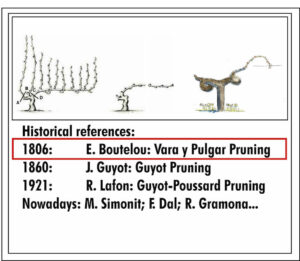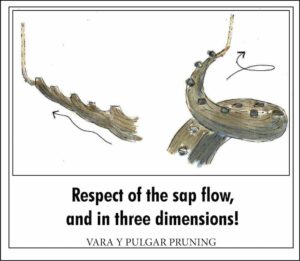They say that the traditional pruning of Marco de Jerez, called “Vara y pulgar”, is like a simple “Guyot”; However, it would be correct to say it the other way around: Guyot pruning is like “Vara y pulgar” pruning, since the documentary records are much earlier.
Pruning is invented and perfected by winegrowers; however, the names that go down in history are those of the engineers who collect them in writing. In this case, it was Esteban Boutelou, director of the Sanlúcar de Barrameda Botanical Garden, who in 1806 published “Memory on the cultivation of the vine in Sanlúcar de Barrameda and Xerez de la Frontera”. In it, he not only described the stick and thumb “Vara y pulgar”pruning technique as a specific and technical pruning system, but also described the organization that existed in Sanlúcar de Barrameda, with some master foremen per neighborhood, who were in charge of teaching the technique to Workers.
This fact, of having an organized training, indicates that the technique existed for at least several previous decades.
In the case of Guyot pruning, it was described for the first time 50 years later in 1860 by Jules Guyot, in his book “Culture de la vigne et la vinification”. Curiously, the publication appeared after his work in the sister French region of Marco de Jerez: Champagne.
More than a century after Boutelou’s publication, in 1921, René Lafon published “Modifications à aporter à la taille de la vigne dans les Charentes. La taille Guyot-Poussard », where he gave instructions on the improvement of Guyot pruning.
In the case of « Vara y pulgar » pruning, there are other documentary references. One of the most relevant is the one published in 1834 by James Busby, father of viticulture in Australia, who toured Spain and France in 1831 collecting data and material to import viticulture to the new continent. In his “Journal of a Recent visit to the principal Vineyard of Spain and France” he records a conversation with Pedro Domecq, owner at the time of the Macharnudo vineyard, in which one of the topics they discuss is the special pruning system for the care and maintenance of the vines.
Thus, the « Vara y pulgar » pruning can be considered as one of the first recorded specific prunings. And its raison d’être can be explained from the particularities of the palomino grape vines, and from the climatic context of Marco de Jerez.
On the one hand, the warm and Atlantic climate of the Marco de Jerez, with mild winters, causes the existence of a wood moth, called “comején”, which was the main cause of weakening of the vineyards. For this reason, they selected a pruning system that minimized the cuts, since it is through them that the insect penetrates the plant. Likewise, the maximum compaction of the vine generates a harder interior wood, which prevents it from attacks.
On the other hand, palomino vines have two specific behaviors: on the one hand, it has a picual behavior, with a bud that pushes ever harder on the buds at the ends of the rod; and on the other hand, the first buds are not very productive, so it requires saws or rods with at least five buds to get suitable bunches.
These particularities were the basis for the design of the « Vara y pulgar » pruning, which, by alternating the load of grapes in two arms, solves the picual and productive behavior, and with the use of a single stick, minimizes cuts.
But the technique does not end there. It also incorporates all the principles of healthy pruning that are currently being revalued by pruning benchmarks (Dal, Simonit, Bourdarias, Gramona, among others): respect for the sap and the dry run; long cuts to respect the sap, cleaning of dead wood, etc.
Although « Vara y pulgar » pruning would require a more extensive publication to know all its details and particularities, we indicate at least eight basic points to understand its value and the precision of its design:
- Respects the sap race, or as they say locally “the green race”, and also does it in three dimensions, with attention and distinction of the sprouting of the buds in “flat” (left and right) or “crossed” (up or down).
- Loading the two arms in productive alternation, minimizing major cuts to a single cut, which is usually sealed (formerly with iron sulfate; and currently with healing pastes).
- Presents maximum precision with a single thumb or fingertip, risking “everything on one card”, compared to other pruning, which seek to have several alternatives, but lose power.
- Get maximum compaction of the wood by using the bud on old wood, as opposed to other prunings, which play with young one-year-old wood, to ensure sprouting.
- It has incorporated the use of cuts at a safe distance so as not to damage the vine (always avoiding cutting close to the sap flow) and with a communication system of “cut and scrape”, which allows speeding up the green pruning steps.
- Develops complementary tasks to improve efficiency: castration, denietation and tying of the “green stick”.
- Alternative responses defined in case of loss of the thumb: grapes for green, pickled grapes, pickled grapes with arrival, round pruning, etc.
- Principles established for the formation of the plant by “grandchildren” or by “faithful”, looking for a crossed sprouting, even with a “heeled” for the first “flat” sprouting.
Even today, in the Marco de Jerez, « Vara y pulgar » pruning is the most used pruning by viticulturists, although the large estates are switching to “double cordon”, since « Vara y pulgar » pruning is not suitable for mechanizing the pre-pruning or harvesting with machines. It also requires specialized workers, who are fewer and fewer in the area. “Double cordon” pruning has the advantage that it allows mechanization and that you can employ unskilled seasonal workers. The detriment is the life of the vine, which after 30 years must be uprooted and replanted. On the other hand, with the “Vara y pulgar” pruning, the vines can live more than 100 years.
In my case, I have been lucky enough to learn “Vara y pulgar” pruning together with great Sanlúcar viticulturists such as Juan Morales, Juan Peregrino or Ignacio Partida, among others. In Sanlúcar de Barrameda and in Trebujena is probably where the greatest wine-growing knowledge of Marco de Jerez resides; It is where there is more “hobby”, where the technique has been most perfected. Each town, even each Pago and each viticulturist has an identity in their way of conceiving pruning and the formation of the vine.
All this knowledge is a huge heritage to value properly.














